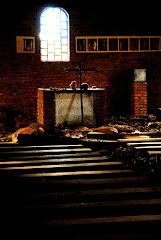
A representation of the Cold War, the 155km long Berlin wall on completion, divided East and West Berlin for 28 years (Wikipedia, 2007). The wall was constructed on August 13, 1961 to prevent East Germans from escaping into the West. After 1948 life in the West was better than the East, due in part to financial help through the Marshallplan from the USA (Burkhardt, 2002-06); and many people were searching for economic prosperity and political freedom from the West (Wikipedia, 2007). Whereas, many people in the East suffered oppression under the Communist party which had been established (Burkhardt, 2002-06); with a Soviet-style planned economy and an authoritarian government (Wikipedia, 2007). In 1952 the East German Government closed the open border between East and West Germany (Burkhardt, 2002-06). Even though this made escaping harder and more dangerous, sectional borders between East and West Berlin were not closed, and often East German citizens would flee to West Germany through West Berlin (Burkhardt, 2002-06). Eventually the East German Government closed the border between East and West Berlin to prevent people escaping via Berlin to the West (Burkhardt, 2002-06).
Although dissatisfaction toward the wall existed, the economy in the East grew due to the elimination of the black market and dual currency damage (Wikipedia, 2007). Eventually, in 1962, a second parallel fence was constructed further into East German territory to create a ‘no man’s land,’ which became known as the ‘death strip’. The wall went through four phases, with the ‘fourth generation wall,’ started in 1975 and completed in 1980, the wall commonly seen in photographs and surviving fragments (Wikipedia, 2007). During the time of the wall, eight border crossings existed between East and West Berlin, with the most famous ‘Checkpoint Charlie’ (Friedrichstraße), which allowed allied personnel, western foreigners and West Germans into East Berlin, and provided necessary permits were held East German citizens could visit West Berlin (Wikipedia, 2007).
It is stated that there were around 5,000 successful escapes into West Berlin during the walls existence; however although there is varying statistics surrounding the number of deaths from attempted crossings, it is believed that 192 people were also killed (Wikipedia, 2007). Guards were told “Do not hesitate to use your firearm, not even when the border is breached in the company of women and children, which is a tactic the traitors have often used” (Wikipedia, 2007, p. 7).
In June 1987, United States President Ronald Reagan delivered his famous “tear down this wall” speech. (I have added a link to a few minutes of this speech).
Although it is commonly accepted that the wall was torn down on November 9, 1989, according to Wikipedia (2007) this date was when borders were stormed due to a message read at a press conference by the East German Minister of Propaganda. New border crossings were opened throughout summer 1990, with the most famous on December 22, 1989 at Brandenburg Gate (Wikipedia, 2007). On June 13, 1990 the East German military began the official dismantling of the wall which continued through to November 1991; and consequently the fall of the wall was the first step toward German reunification which was officially completed on October 3, 1990 (Wikipedia, 2007).
As well as many other performers, David Hasselhoff performed live at the Berlin Wall with his song “looking for freedom” which appealed to many German people during the arduous times surrounding the wall (Wikipedia, 2007). I have added a link to a youtube version of this song being performed live at Berlin; however the quality is not great.
Three sections of the wall in its original site still exist, even though most of the wall was destroyed; the remainders of the wall are in bad condition partly due to damage by souvenir seekers (Wikipedia, 2007). I also managed to buy a souvenir of the wall while I was in Germany. Even so, a private museum rebuilt a 200-metre section near Checkpoint Charlie, fifteen years after the fall (Wikipedia, 2007). Although the wall is gone, cultural differences are still rumoured and some Germans wish the wall was once again restored in Berlin, described as “Mauer im Kopf” (“The wall in the head”) (Wikipedia, 2007, p. 11).
While researching the history of the Berlin Wall I found lots of different sites and information however I feel these words really encapsulate the imaginary wall which still exists in many parts of the world today.
“In a way, the Berlin Wall is a reminder to us that there are still plenty of walls waiting to be torn down. These walls are not made of concrete or barbed wire. They are not made of sticks or bricks or mud or wire. These new kind of walls cannot be touched or seen but we know that they are there. These kinds of walls are built of words, words that are full of hate and anger and superiority. These walls are built on ignorance or prejudice. They are constructed on the fear of difference. These walls are built on words and actions that are in any way racist or discriminatory” (Caritas Australia, 2002, p. 1).
The Berlin Wall was a huge reminder of the discrimination that existed within Germany and according to the paragraph above, discrimination most certainly remains within today’s society. Understanding the flaws still evident within society is an important and necessary aspect for all people. Hopefully one day the “walls” built by members of society will also be torn down, and the first piece starts with us all.
I would really appreciate any thoughts or comments of personal experiences or knowledge surrounding the Berlin Wall and discrimination, particularly in relation to today's society.
Thanks!
References
Burkhardt, H. (2002-2006). Berlin Wall Online. History of the Berlin
Wall: Why the Wall was built up. Retrieved August 17, 2007 http://www.dailysoft.com/berlinwall/history/why-the-berlinwall-was-built.htm.
Caritas Australia. (2002). Backgrounder – tear down these Walls.
Caritas Australia. (2002). Backgrounder – tear down these Walls.
Retrieved August 17, 2007
http://www.ozspirit.info/2002/28bg.html
Wikipedia. (2007). Berlin Wall. Retrieved August 17, 2007
http://en.wikipedia.org/wiki/Berlin_Wall
Wikipedia. (2007). Berlin Wall. Retrieved August 17, 2007
http://en.wikipedia.org/wiki/Berlin_Wall






1 comment:
When I've visited to Berlin, I was very keen to see the Berlin Wall. they all gave interesting history about the Berlin Wall. I'm history fan and I found this very moving and exciting to see.
Berlin places to visit
Post a Comment